Salmon Sashimi Doniburi is a delicious Japanese rice bowl topped with fresh buttery salmon, fragrant shiso, ikura, and scallions. This quick bowl comes together in minutes for a light meal and will leave you feeling satisfied and full. Serve with a side of wasabi, soy sauce, or homemade yuzu ponzu sauce.
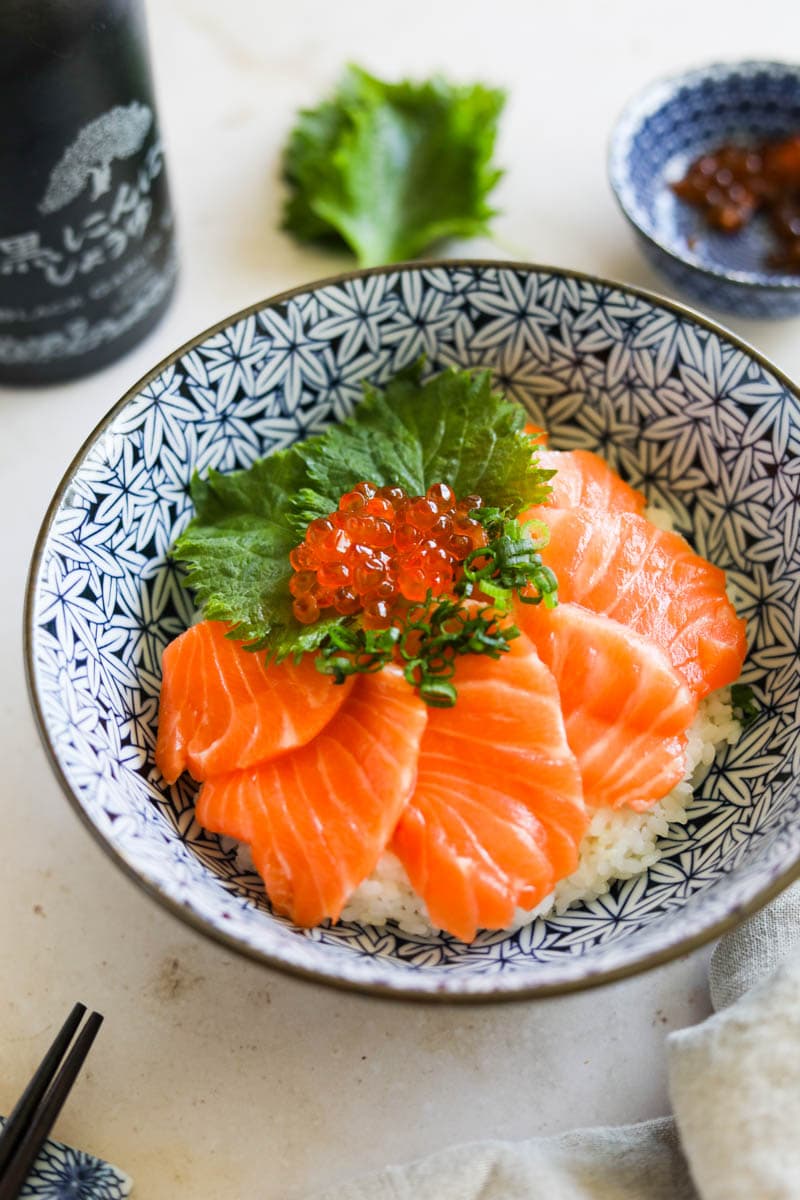
We love salmon sashimi, but have found it isn't enough for a whole meal on its own. In order to make it a complete meal, we enjoy it in a rice bowl with tasty toppings. The combination of creamy salmon, rich ikura, and fragrant shiso leaves create a refreshing and balanced meal.
If you are looking for other dishes to serve with white rice, check these out.
Jump to:
About Salmon Donburi
- Taste - The rich salmon, briny ikura, and aromatic scallions create a delectable flavor medley.
- Texture - The salmon is soft and buttery, the scallions are crunchy, and the rice is firm.
- Effort - Other than precisely cutting the fish, you just need to make the rice and add the toppings.
- Time - It takes about a half hour to cook the rice then another 5 minutes to slice the sashimi and assemble the don.
What is a donburi?
Donburi translates to "bowl" in English. These bowls typically feature fish or meat over steamed Japanese rice. We often add a delicious dressing like teriyaki or ponzu sauce for extra flavor.
What is sashimi?
Sashimi is a simple and elegant dish featuring thinly sliced raw fish. The fish is typically served by itself (or with shoyu, or soy sauce) because the flavor of the fish is the main component. Dipping the fish in shoyu dipping sauce adds a rich umami flavor.
Ingredients
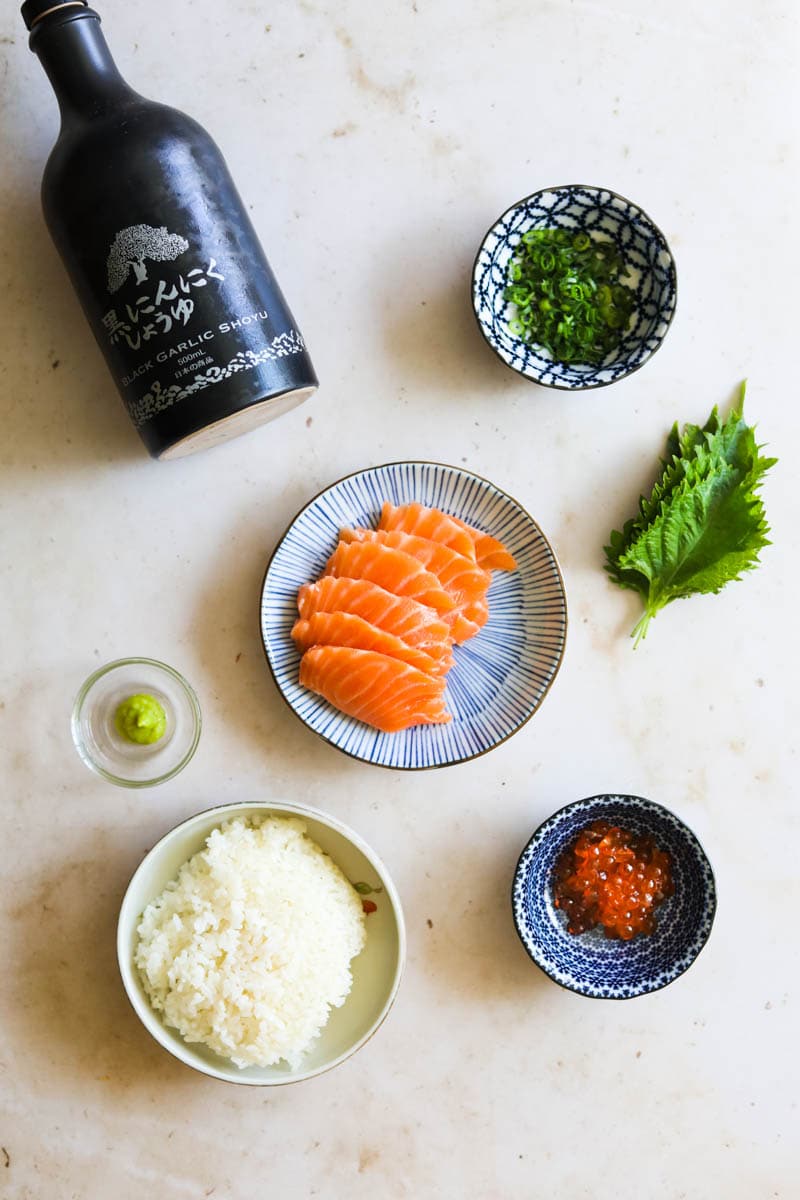
- Sushi Grade Salmon - Fresh, sushi grade or sashimi grade salmon sashimi is key to a tasty, safe salmon bowl.
- Rice - Japanese short grain rice is best because it is fluffy and lightly salted for flavor.
- Ikura - Ikura adds a salty and briny ocean flavor.
- Shiso leaves - Shiso leaves add a fragrant and sweet accent to the bowl.
- Scallion - Scallion adds an aromatic flavor and a light crunch.
Substitutions
- Yellowtail Sashimi - Yellowtail is a firmer fish that is more mild flavored.
- Ikura - Make an ikura don if you like the texture and rich briny taste of ikura. Just keep in mind that ikura is expensive. Given how rich ikura is, we often enjoy ikura dons in smaller bowls than sashimi donburis.
- Meat - Seasoned and sliced cooked beef or chicken will also work well in a donburi.
Variations
- Soy sauce - Soy sauce, or shoyu, adds a deeply umami-rich component.
- Wasabi - Wasabi adds a pungent spice.
- Pickled ginger - Add some pickled ginger for a mild ginger flavor that is refreshingly sweet and sour. Pickled ginger is particularly great if you plan on eating other sashimi or sushi with this dish because it will cleanse your palate between the different dishes.
- Nori - Add small chopped nori pieces for extra crunch and seaweed flavor.
- Tobiko or masago (Flying Fish Roe) - Replace ikura with tobiko or its cheaper cousin, masago, for a slightly sweeter roe.
- No rice - We often enjoy this dish with rice because it's neutral flavor pairs well with the sashimi. However, if you want the sashimi to really shine, eat it without the rice and just a little bit of shoyu.
- Eel sauce - Drizzle the donburi with some eel sauce (Unagi no tare) to add tangy sweetness to the sashimi. Eel sauce is a sake, mirin, sugar, and soy sauce reduction.
- Sushi rice - Add seasoned rice vinegar to normal rice to make sushi rice. The vinegar adds a light sweet and tart flavor to the rice.
- Furikake - Furikake is a Japanese seaweed seasoning commonly made of dried seaweed, sesame seeds, and salt. It adds an ocean-like flavor to this seafood dish.
- Yuzu Ponzu sauce - Enjoy yuzu ponzu sauce on the side for dipping. Yuzu ponzu sauce is a tangy and citrusy sauce that is slightly lighter than shoyu.
- Other dishes to serve with
See recipe card for quantities.
Instructions
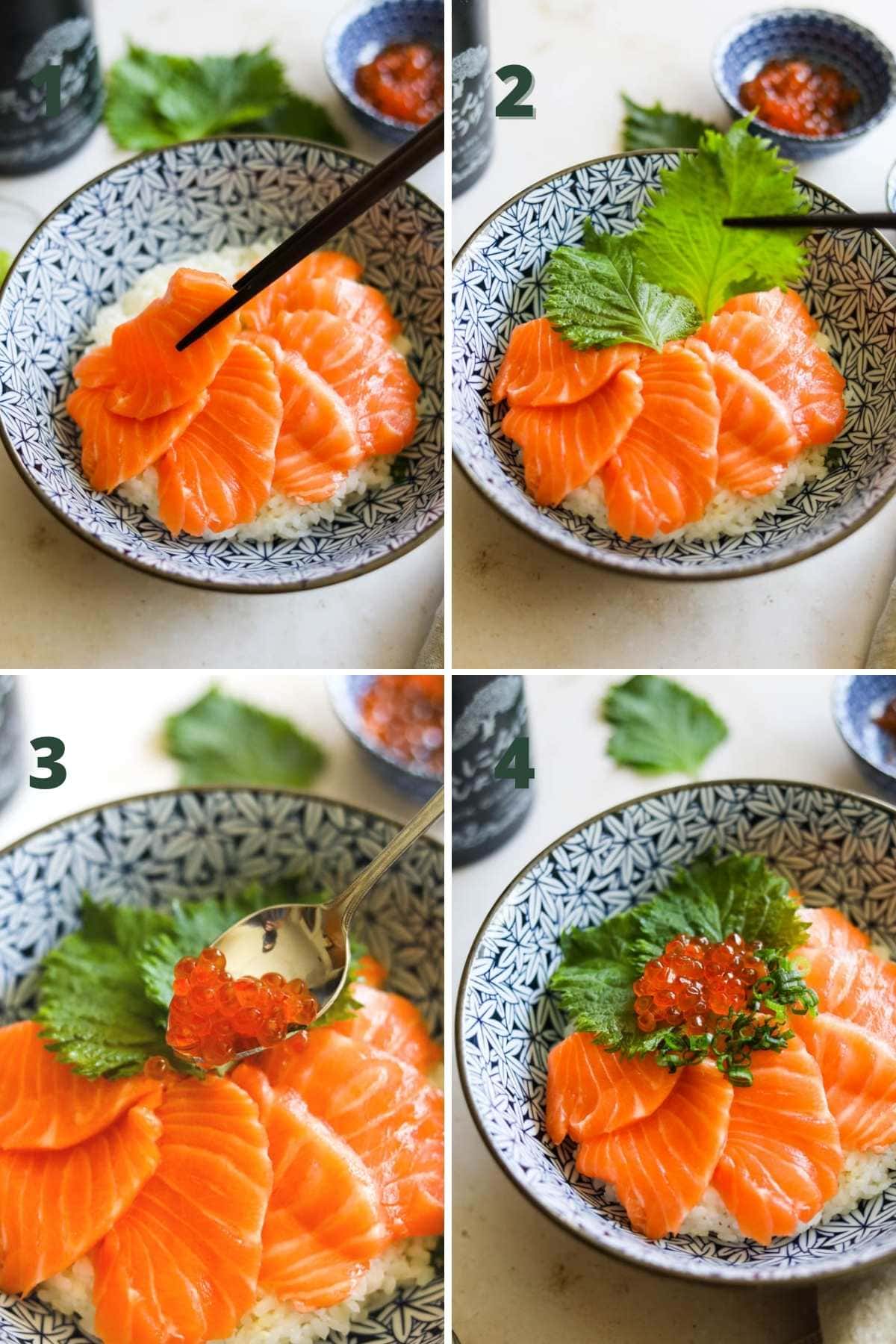
- Make rice - Rinse rice in a bowl until it runs clear. Then make rice on the stovetop or in an electric rice cooker pot. Remove from heat and fluff with a fork. Then transfer to rice to a bowl and season with seasoned rice vinegar. Fluff and fan the rice until slightly cooled.
- Thinly slice salmon - Carefully slice salmon against the grain at a 45° angle. Be sure to pick how large you want the slices ahead of time and cut in one smooth motion. A standard thickness is about ⅜-inch thick. Then place the thin slices of salmon over rice.
- Assemble the bowl - Place the shiso leaf and ikura on top of the salmon. Serve with soy sauce and wasabi on the side.
Hint: Sashimi should be cut with a very sharp knife to ensure the pieces are pristine. Cut the fish across the grain and perpendicular to the spine to ensure the fragile proteins in the fish remain undamaged. Hold your knife steady and cut in one smooth motion to ensure the pieces are immaculate.
How to Enjoy this Salmon Donburi
This salmon rice bowl is best enjoyed by combining a little bit of each ingredient in a megabite. The combination of neutral rice and rich ingredients is delicious. If you want to enjoy this sake sashimi with a tasty side, it pairs wonderfully with these other Japanese dishes:
- Spicy Kani Salad
- Spicy Kani Roll (Crab Sushi)
- Furikake and Lemon Shishito Peppers
- Ebi Tempura (Crispy Japanese Shrimp Tempura)
FAQ
The ingredients are usually available at Japanese markets, like Mitsuwa or Nijiya, or some common chain grocery stores. Sushi grade salmon is also usually available in Japanese grocery stores, Whole Foods, or small specialty grocers. If they don't have it, you can also go to a local fish monger or seafood market. If you are based in the San Francisco Bay Area, we highly recommend Four Star Seafood, a chef-curated grocery service.
Yes, both salmon and ikura are high in healthy fatty acids, including high-quality omega 3 fatty acids. Salmon is also high in vitamins, minerals, and other essential nutrients. The only part of this dish that isn't super healthy is white rice since it is high in carbohydrates without a lot of added nutritional value. If you want to make this dish healthier, you can use brown rice instead of white.
While salmon sashimi is raw, it is safe to eat. Just make sure that you don't leave it unrefrigerated for an extended period of time. Also, don't eat it if you are pregnant due to the risk of harmful bacteria and parasites. See FDA guidelines about eliminating parasites when eating raw fish.
Essentially, there is no difference. Both labels typically mean the fish was flash frozen to kill parasites. Since there is no universal grading system for quality fish the way that the USDA grades beef, the label of "sushi grade" or "sashimi grade" just means that the vendor has judged the salmon safe to be eaten raw. As a result, the claim of sashimi grade or sushi grade fish is only as trustworthy as the vendor making the promise.
While both include the use of sashimi or sushi grade salmon, salmon sashimi typically only features salmon while salmon sushi features salmon, sushi rice, and nori (among other ingredients).
Equipment
This eel donburi recipe requires a few kitchen essentials. To make this donburi, you will need a knife, cutting board, mixing bowls, a pot or rice cooker to make the rice, and a rice paddle.
To explore more kitchen items to make your kitchen complete, head to our Kitchen Essentials Shop.
How to Store Unagi Donburi
This uangi donburi is best enjoyed immediately or within 1 day of making. Store the ingredients in an air-tight container in the refrigerator. The key is to keep the moisture locked in so the rice doesn't dry out. This eel donburi recipe does not stand up well to freezing.
Top tips
- Cool the rice - Make sure the steamed rice is cool before adding the fish. The temperature of the rice should match the temperature of the fish so the delicate fish doesn't cook.
- Fish medley - Add hamachi or tuna for a yummy fish medley.
- Sauce on the side - Serve with soy sauce on the side instead of on top so the rice stays sticky and won't fall apart when you try to eat it.
- Use a bowl - Serve this dish in a large bowl or donburi bowl (slightly smaller than ramen bowls) to ensure all of the ingredients will fit.
Did You Like this Recipe?
If you liked this Salmon don recipe, please rate and comment on the recipe below! If you want to make other rice bowls or similar Japanese dishes, check these out:
- Spicy Ahi Poke (Spicy Tuna Bowl)
- Miso Salmon Crudo (Carpaccio)
- Broiled Miso-Glazed Salmon
- Ikura Donburi (Salmon Roe bowl)
- Yellowtail Sashimi Bowl (Hamachi Donburi)
- Teriyaki Salmon Bowl (Donburi)
- What to Eat with White Rice: 21 Tasty Recipes
📖 Recipe
Salmon Sashimi Donburi (Rice Bowl)
Equipment
Ingredients
- 1 cup rice
- 1⅓ cup filtered water
- ½ lb sashimi grade salmon sliced
- 2 tablespoon ikura
- 1 scallion finely sliced
- shoyu for serving
- wasabi for serving
- shiso for garnish
Instructions
Rice
- Stovetop instructions - Place rice in a saucepan and rinse the rice in the sink until the water runs clear, then drain. Combine washed rice and filtered water in a medium saucepan. Bring the rice to a low boil, then reduce the heat to low. Cover the pot and simmer for 20 minutes or until the water is absorbed. Remove from the heat and let sit covered for 10 minutes. Fluff the rice with a fork.1 cup rice, 1⅓ cup filtered water
- Rice cooker instructions - Place rice in the electric rice cooker pot and rinse the rice in the sink until the water runs clear, then drain. Combine rice and filtered water in the pot and cook per the rice cooker directions.1 cup rice, 1⅓ cup filtered water
- Cool rice - Let the rice cool while you prep the other ingredients.
Salmon Sashimi Donburi
- Thinly slice salmon - Carefully slice salmon against the grain at a 45° angle. Be sure to pick how large you want the slices ahead of time and cut in one smooth motion. A standard thickness is about ⅜-inch thick.½ lb sashimi grade salmon
- Assemble the bowl - Once the rice cools, divide the rice into the two bowls. Then place the thin slices of salmon on top of the cooled rice. Place the shiso leaf, scallions, and ikura on top of the salmon. Serve with soy sauce and wasabi on the side.2 tablespoon ikura, 1 scallion, shoyu, shiso, wasabi
Notes
- This salmon donburi is best enjoyed immediately or within 1 day of making. Store the ingredients in an air-tight container in the refrigerator. The key is to keep the moisture locked in so the rice doesn't dry out. This salmon donburi recipe does not stand up well to freezing.
- Cool the rice - Make sure the steamed rice is cool before adding the fish. The temperature of the rice should match the temperature of the fish so the delicate fish doesn't cook.
- Fish medley - Add hamachi or tuna for a yummy fish medley.
- Sauce on the side - Serve with soy sauce on the side instead of on top so the rice stays sticky and won't fall apart when you try to eat it.
- Use a bowl - Serve this dish in a large bowl or donburi bowl (slightly smaller than ramen bowls) to ensure all of the ingredients will fit.


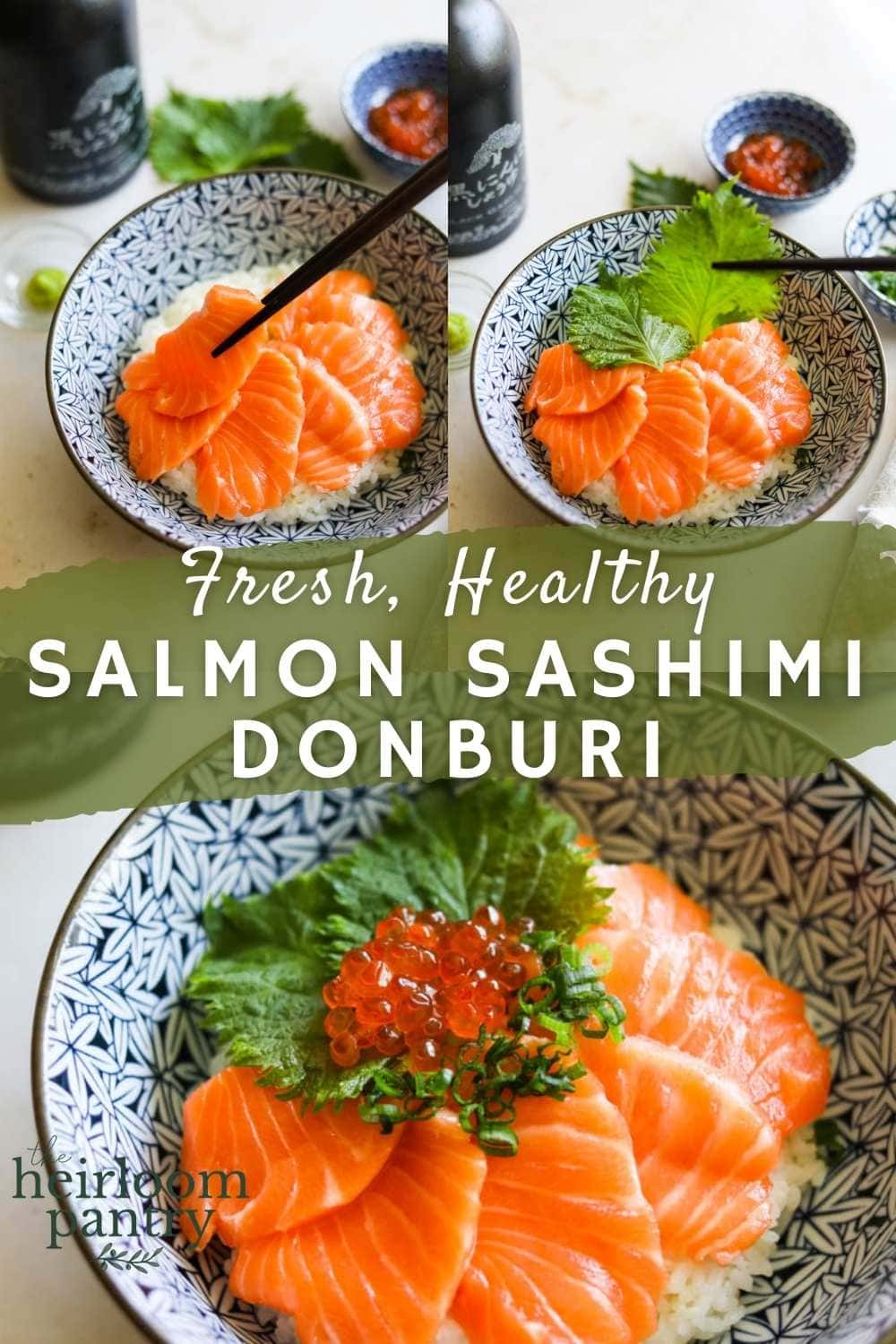
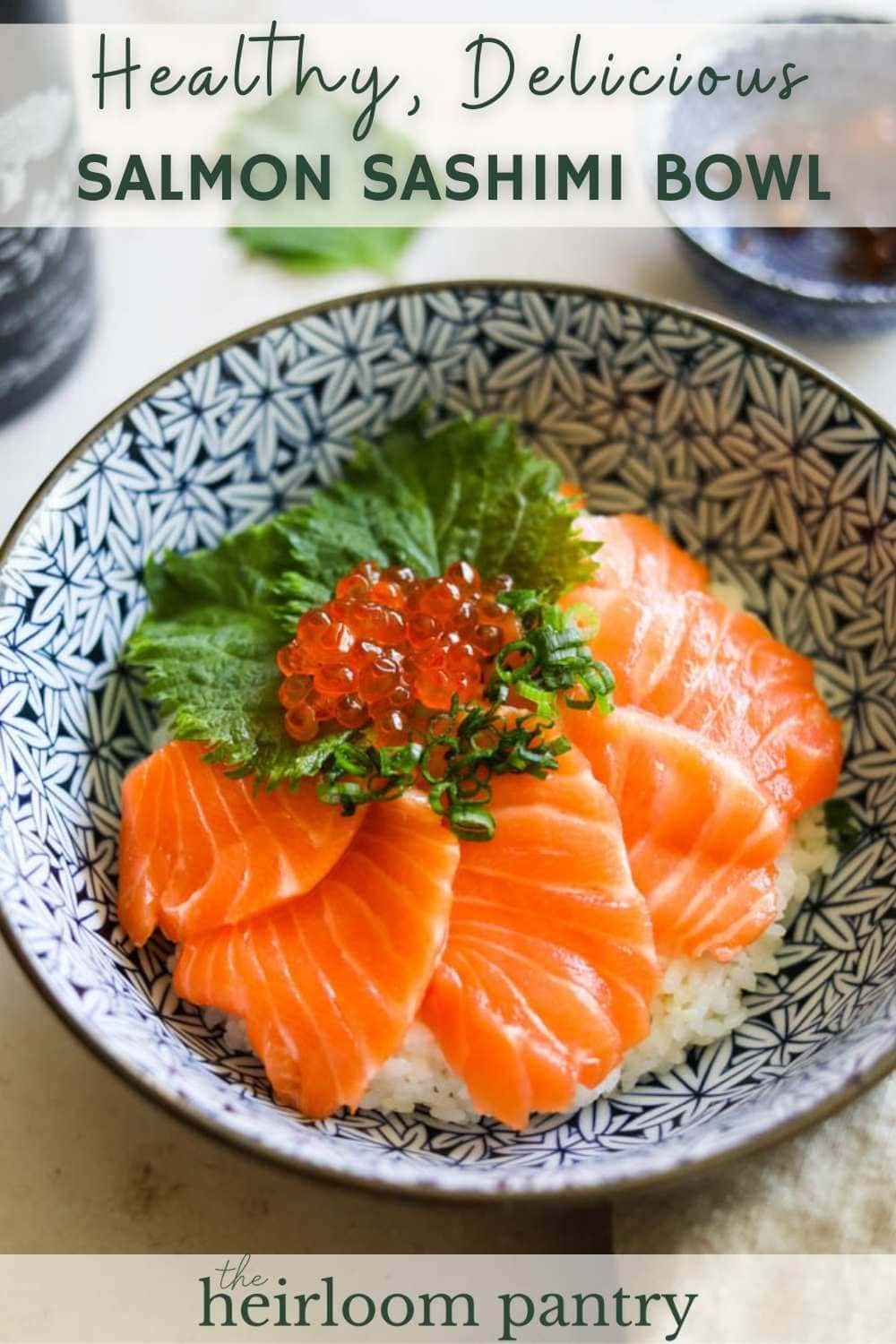
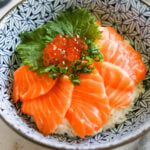
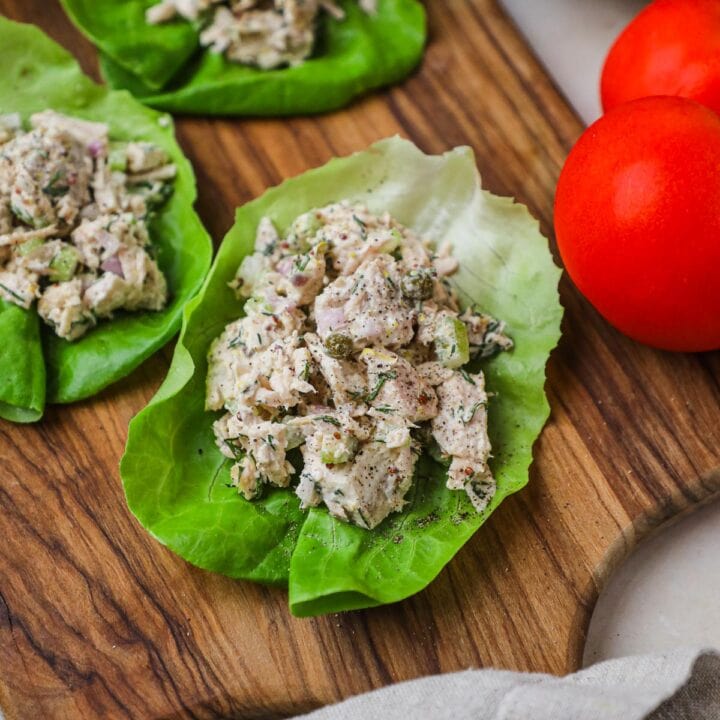


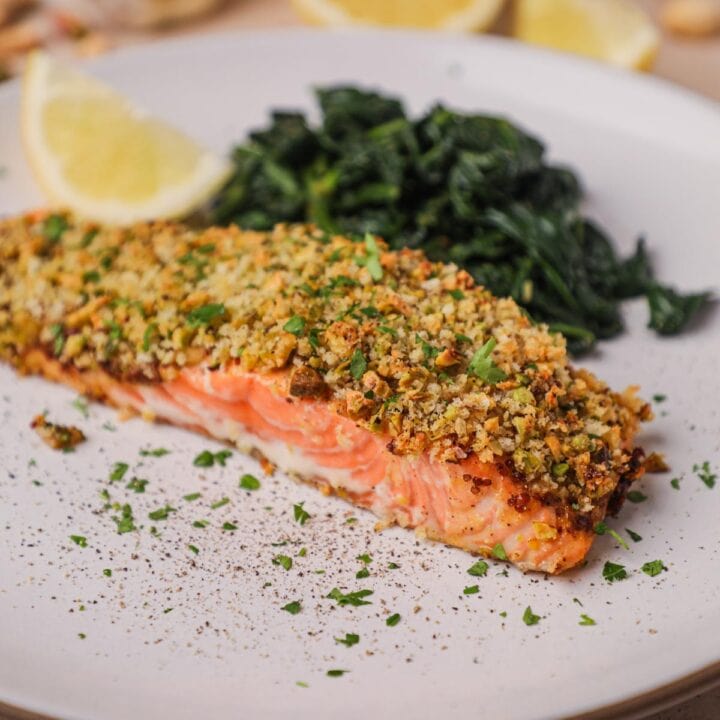
Leave a Reply